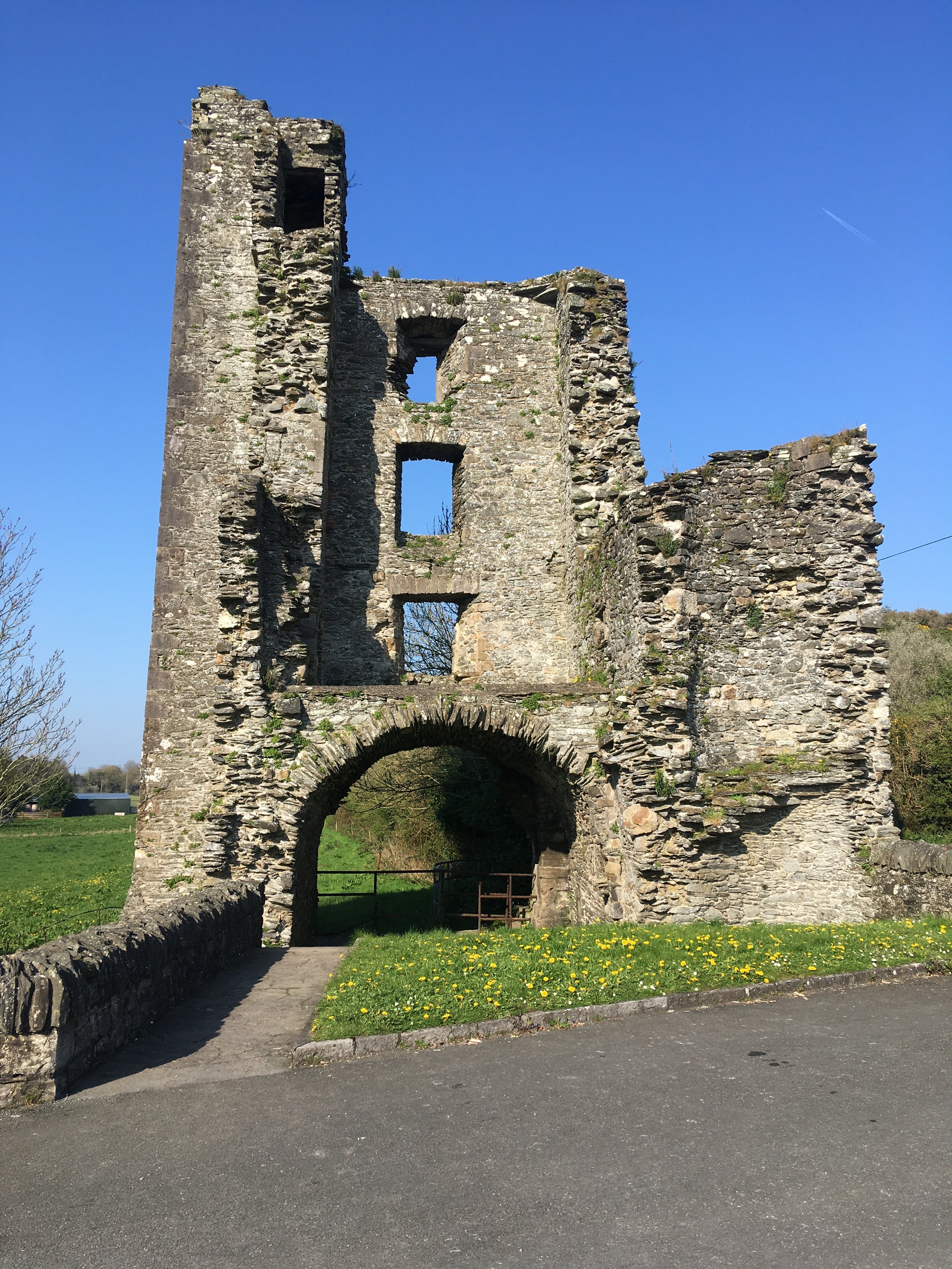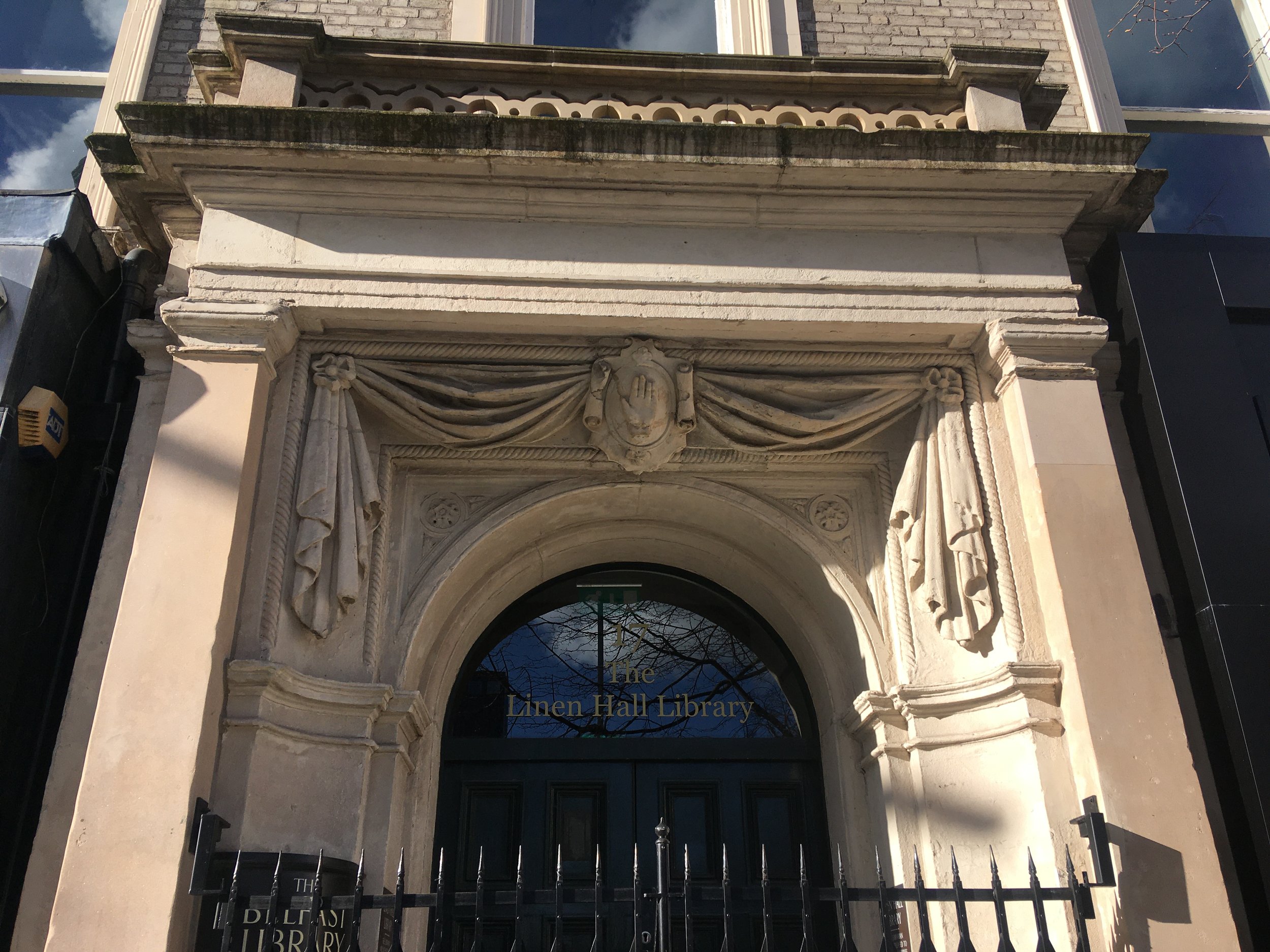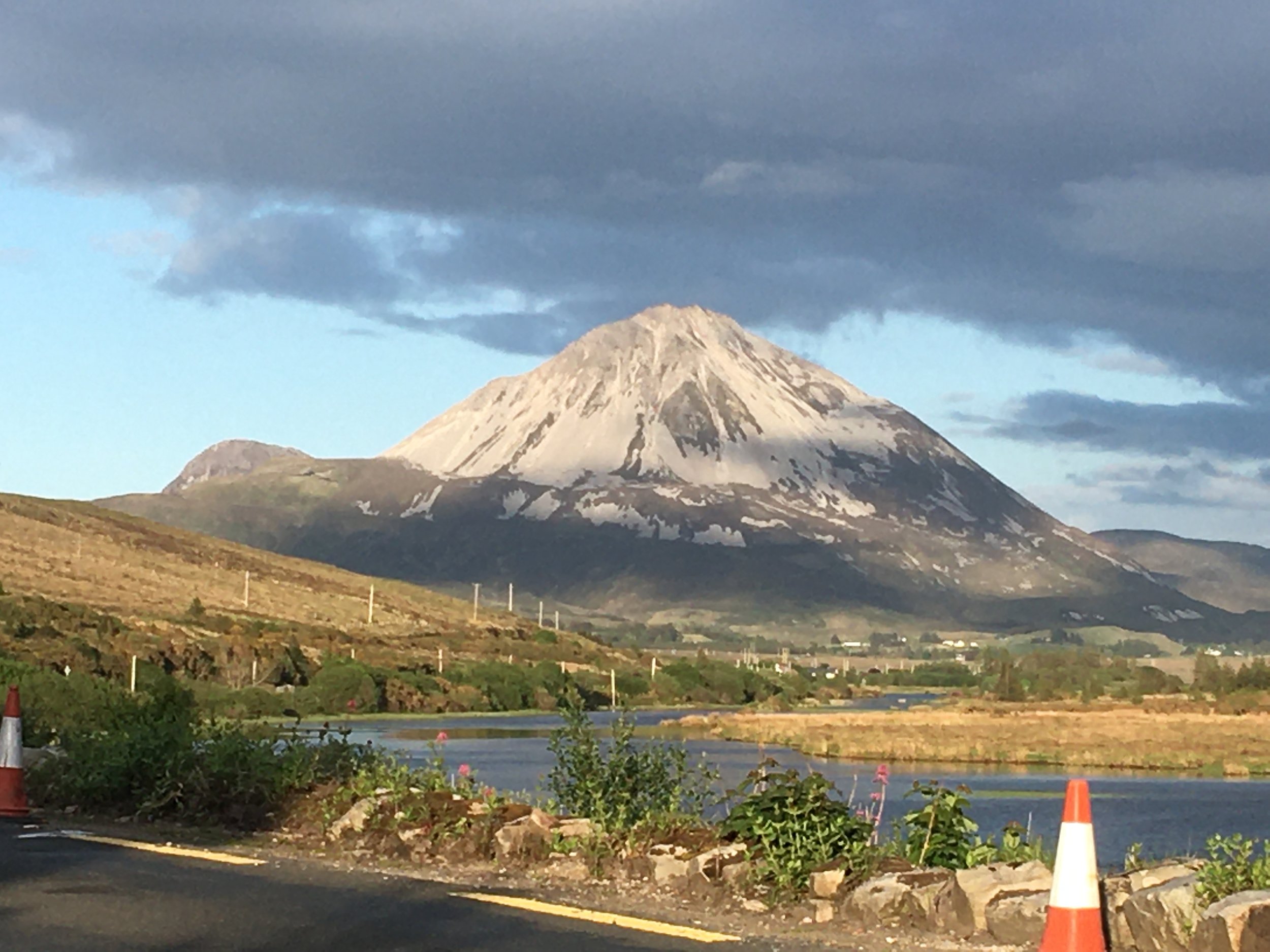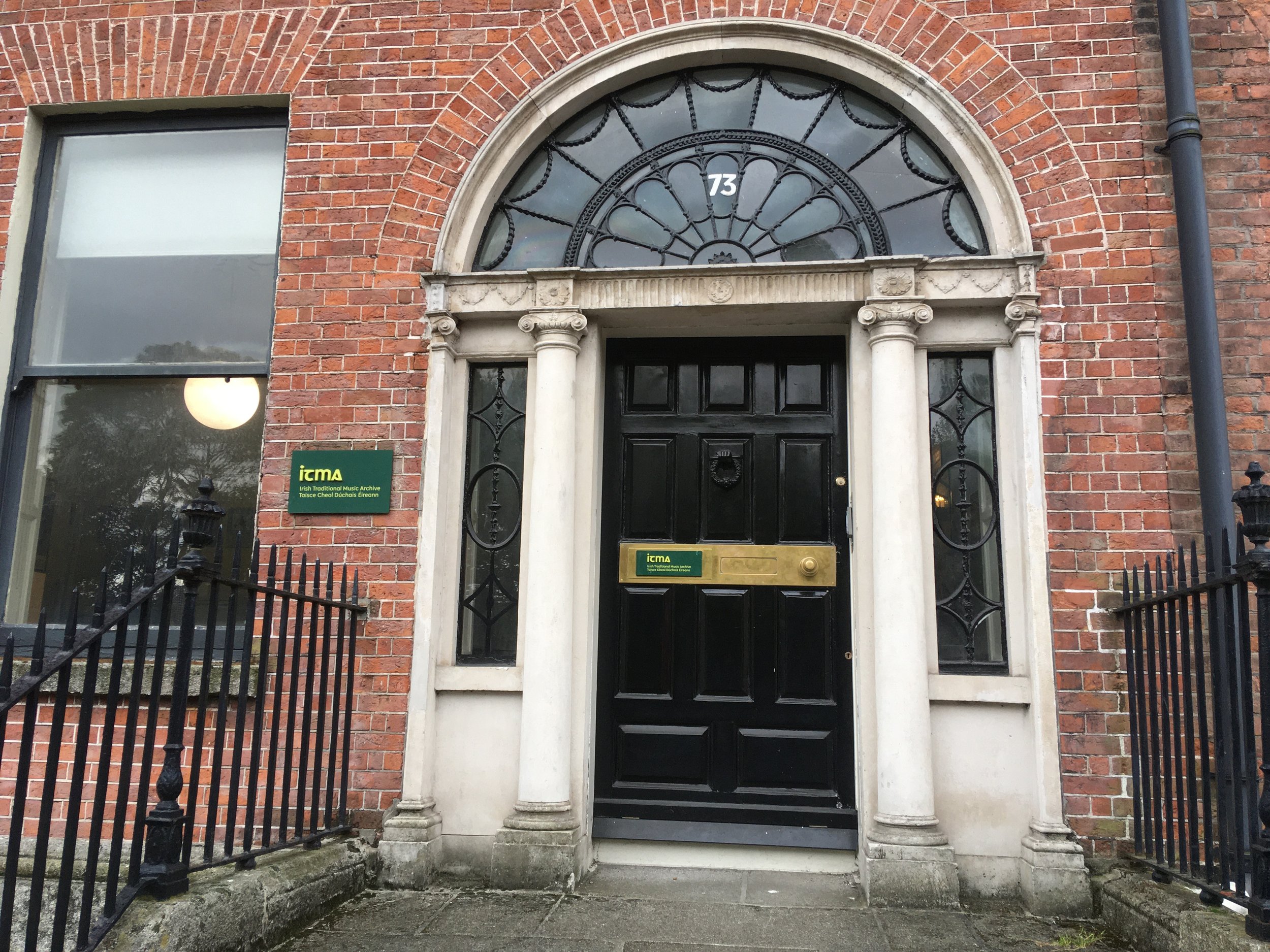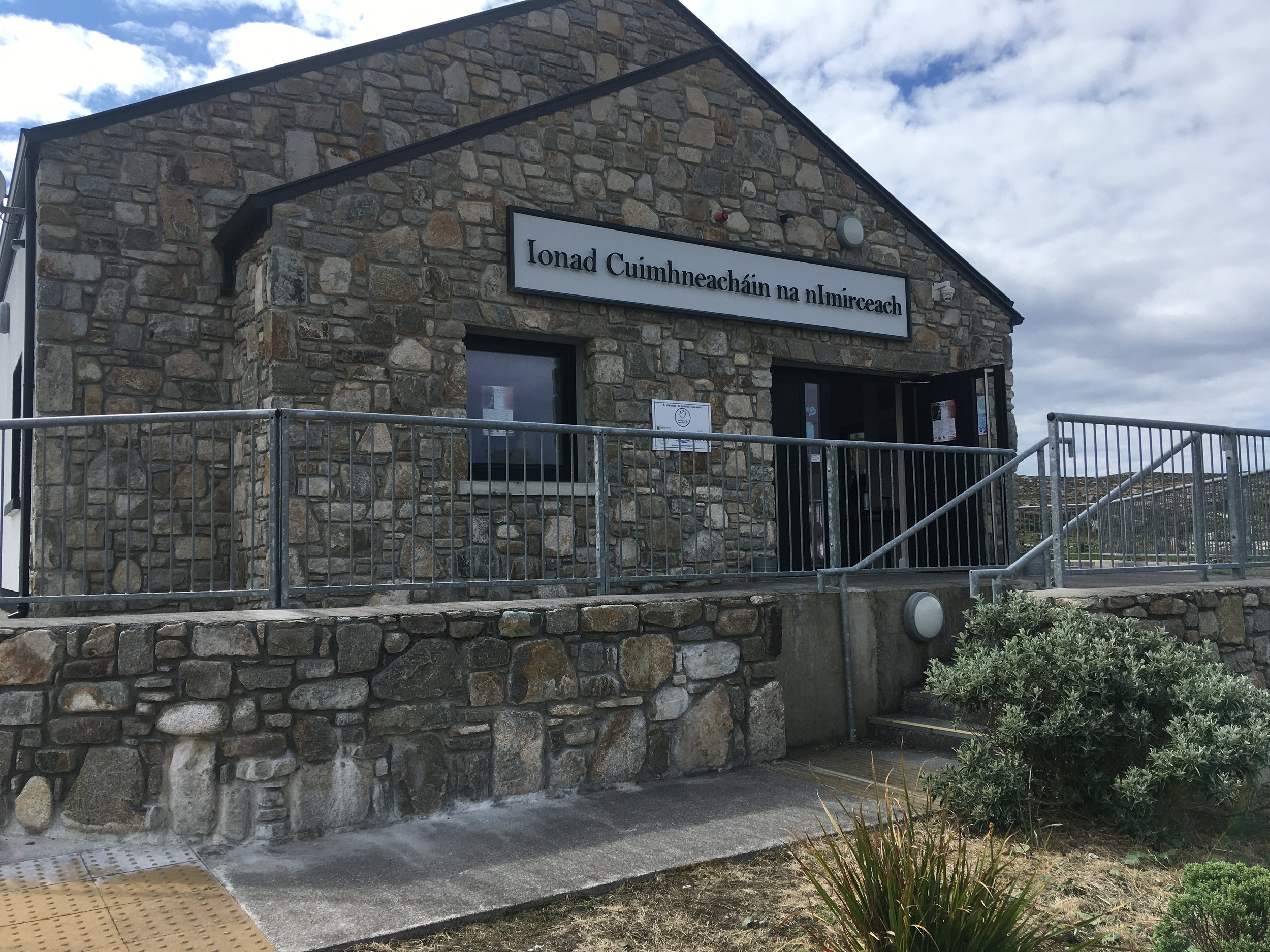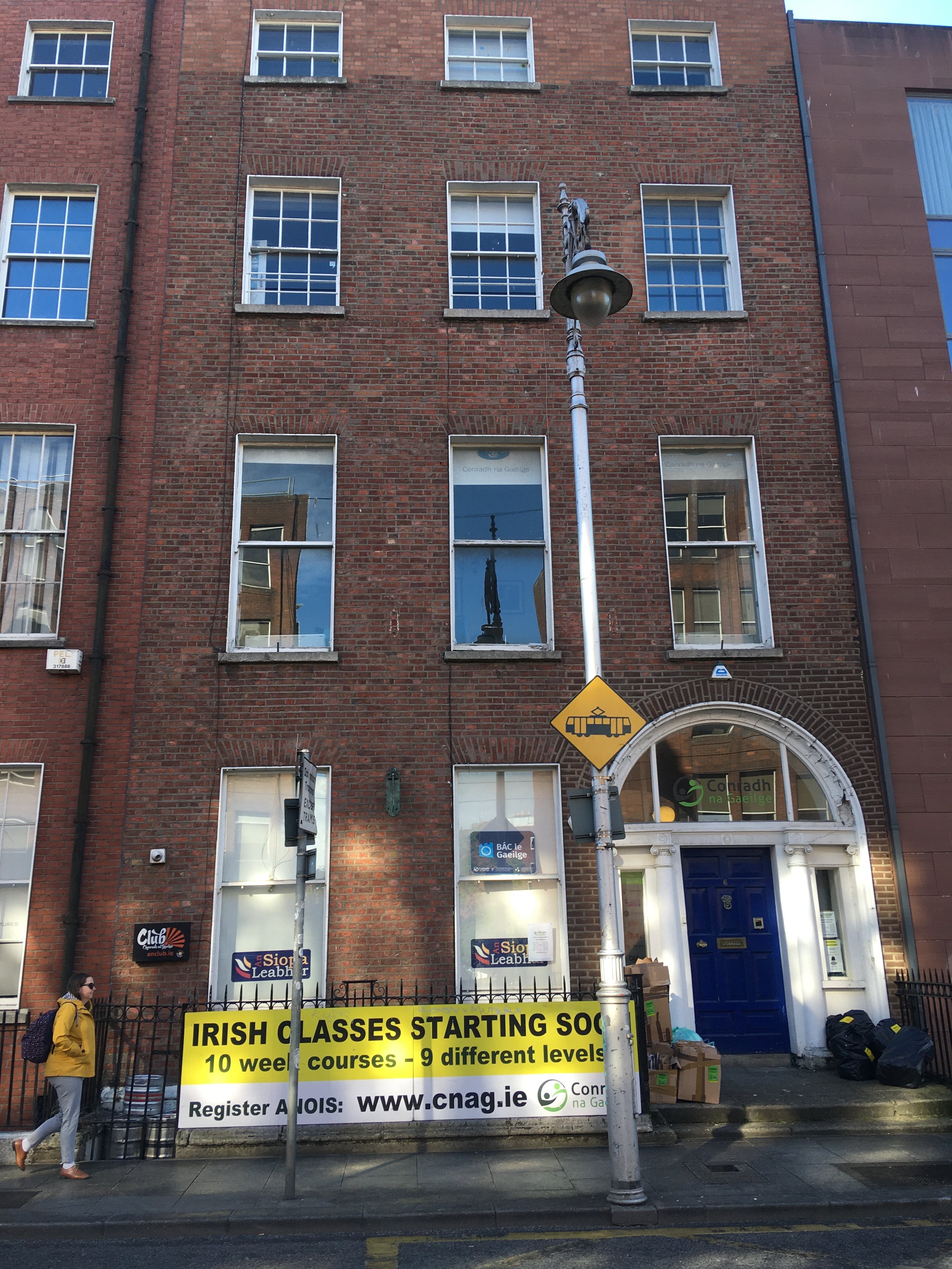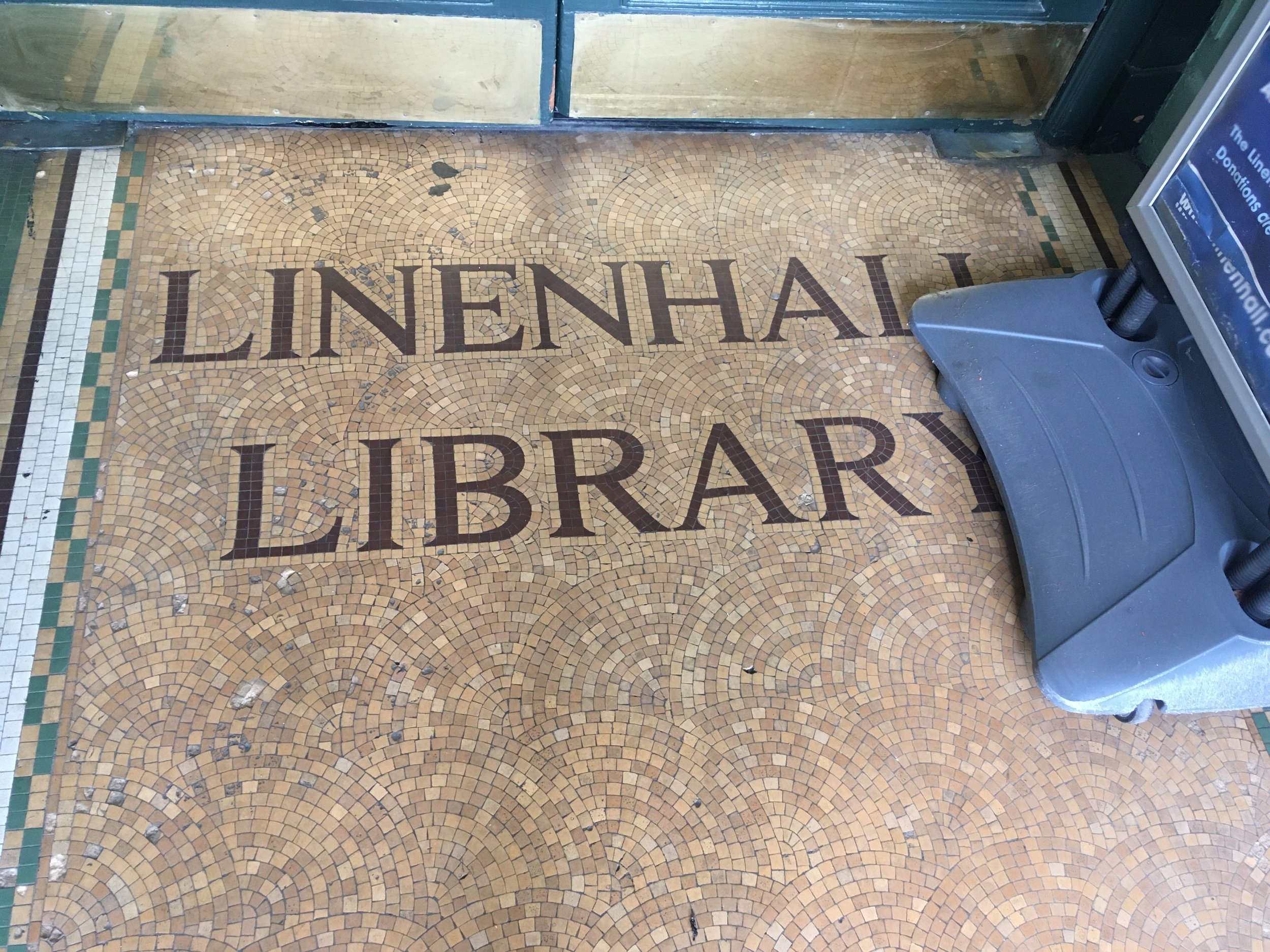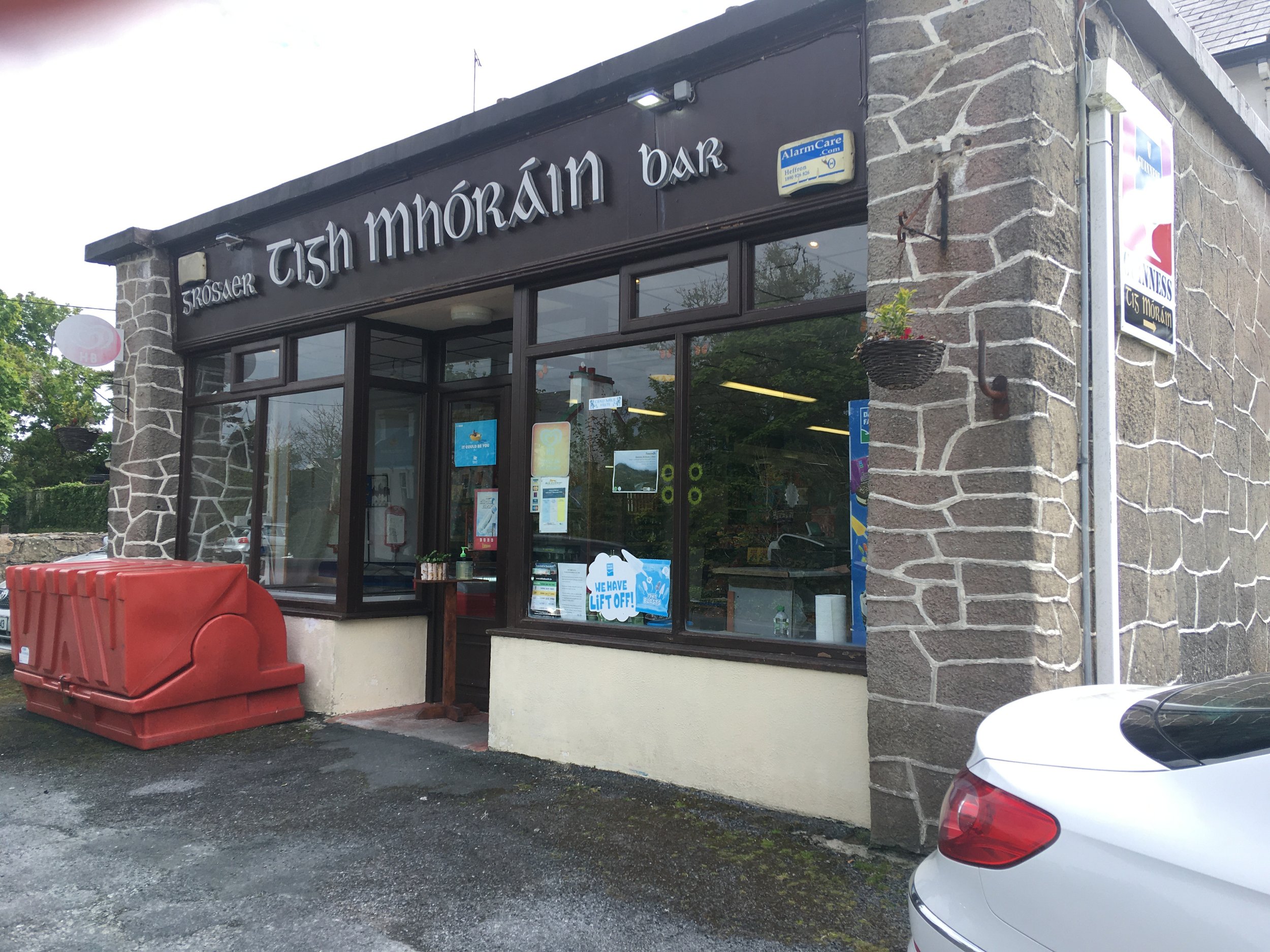Notes and photos of my visit to Ireland, 2023
27 to 30 April
The last four days of this year’s trip to Ireland I spent in Dublin. I visited the Irish Traditional Music Archive and made arrangements to contribute my information about “Smiling Aghadoe,” the more than one hundred year old song I discovered had never been collected or published. (See the story HERE.) The very helpful librarian, Róisín Conlon, also helped me find information about the singing styles employed by the ballad mongers of the nineteenth and early twentieth centuries. Then I went to the Teachers’ Club where An Góilín Traditional Singers meet every Friday evening in a beautiful chandeliered room. I was honoured to be the guest artist for the session and sang nine well-received songs, putting an exclamation mark at the end of my trip.
The front entrance to the Irish Traditional Music Archive, which is in a beautiful old Georgian house.
The chandeliered and gold-decorated ceiling of the room in the Teachers’ Club where the traditional singers meet every Friday evening.
23 to 26 April, 2023
I spent several days in the beautiful Glenfarne Valley, Co. Leitrim, where I had the honour of being the guest artist at Rosie Stewart’s Rainbow Singing Club session in McHugh’s. The name of the valley is actually redundant, for Glen already means valley. The farne part is actually fearn in Irish and means alder. Hence, Alder Valley. Unfortunately for its name, the forestry plantations on the opposite hillside are all coniferous and none of them alder.
My first pint was on the house because “It’s your first time here.” I understand that on major holidays your first pint is free for everyone. Savvy marketing!
19 to 22 April
My mountain in Ireland this year was Croagh Patrick, with a 2500 foot summit overlooking Clew Bay. Yes, by Oregon standards it’s just a hill but I’ll tell you it’s one of the most difficult climbs I’ve ever done. The last half of the ascent is unrelentingly steep, among the steepest I’ve ever attempted. I almost gave up at one point—the wind was also unrelenting and frequently unbalancing—but then looked at Google Maps on my phone (connectivity is amazing in Ireland!) and saw that I was less than 300 yards from the top! A little rest was all I had needed. I asked the two hundred or more people I met going up and down where they were from. I got fascinating results, summarized here: 14 countries represented; 18 of the 32 counties in Ireland; 7 states of the US. I’ll put the details up later.
Bust of John MacBride, a local hero of the War of Independence. He was executed by the English in 1916. To the right is the view from the top looking north over Clew Bay with its scores of little islands.
View of the summit from half way up. To the right is the view of Croagh Patrick from across part of Clew Bay. The little blip at the summit (a little to the right of what appears to be the summit from this angle) is Teampall Phádraig, Patrick’s Oratory
11 to 18 April, 2023
While in Drogheda I drove a little ways up the Boyne River valley which is rich in historical sites and ruins, from five thousand years ago (Newgrange, Knowth, and Dowth) through pre-Christian remains (Tara) to Medieval and more modern events. I visited the site of the Battle of the Boyne (1690), the start of the Williamite Wars which resulted in William of Orange taking over the monarchy of the English Empire and solidifying Protestant power. Then I visited the ruins of Mellifont Abbey, established in 1142 by the Cistercians, an extremely strict order originating in France. It housed up to 500 religious and lay brothers at its height in the thirteenth century. It’s rise resulted in the demise of the next place I visited, Monasterboice, which was established by St. Buithe in the sixth century and is famous for its three tenth century high crosses and round tower.
A remnant of the gate of the outer defensive wall of Mellifont Abbey.
Threatening-looking but effectively constructed arched passageway at Mellifont Abbey.
The Monasterboice round tower—110 feel tall—built in the tenth century as a defense against Viking raids. It is missing its conical top but is otherwise in excellent condition.
Cannon at the Battle of the Boyne Visitors’ Center.
Detail of the remaining cloister at Mellifont Abbey.
One of the three tenth century high crosses at Monasterboice with Biblical scenes carved into the upright.
Mellifont Abbey ruins. Most of the old buildings were torn down for their valuable building materials. Much of what we see is the excavated remains.
Part of the Lavabo (at Mellifont Abbey) where the monks “purified” themselves with water.
Another of the early high cross at Monasterboice.
After a brief visit to Dublin to hear my friend Libby Healy singing—wonderful, inspiring—as the guest artist at An Góilín (where I also have the honour of being guest artist on 28 April) I went to Drogheda, about 30 miles north of Dublin. It was established about 900 years ago close to the mouth of the Boyne River and is the site of one of Cromwell’s more horrific war crimes, the slaughter of perhaps over a thousand civilians after the hostilities were over as well as hundreds of opposing soldiers who had surrendered. John Philip Holland, the inventor of the submarine, taught math and music to students here in the late nineteenth century.
Magdalene Bell Tower, ca. 1300’s
St. Lawrence Barbican Gate or outer fortification, ca. 1200’s
I hiked up Carrowkeel hill to visit some of the neolithic remains at the top. Although they’ve never been properly excavated, it’s assumed they are the graves of leaders of three or more thousand years ago. There are at least eight of them at the summits of nearby hills in south-central Sligo. I visited just two. Mountainy sheep are ubiquitous in the upper reaches of heathery Irish hills. The orange spot is the owner’s brand.
8 April, 2023
Forty years ago I met Thomas and Nora Lernihan. I wrote about that experience in my blog HERE, calling it The Tractor, the Bicycle, the Song. This past Saturday I went back to the same little town, Connelly, Co. Clare, to see if I might find any trace of them: children, relatives, neighbours. The amazing results are now posted to my Field Research, Blog page, HERE.
3 to 10 April, 2023
After recovering from covid and leaving Tom and Leona’s generously offered cabin retreat, I spent two days in Derry, which still has its Medieval walls intact. I sing a song about St. Colmcille, the patron saint of Derry, and got a lot of shots of his recently-installed statue there. I’ll be making a music video of the song and shots of the statue (stay tuned). The statue symbolizes his name—Colm means dove—and also his love of nature.
I spent two days in Belfast participating in two sessions there, at the Garrick Pub and the Sunflower Club, and also an afternoon at the Linen Hall Library, researching more about the background to the song, Bonnie Portmore.
On the way from Belfast to Tulla, Co. Clare (for the Robbie’s First Friday singing session) I stopped at the Giant’s Ring, a Neolithic earthen ring with a dolmen or passage tomb in the center. It is estimated to have been built in about 2700 B.C.E., predating the Egyptian pyramids. You can get an idea of its huge size from the satellite image below, right. It’s the almost-perfect circle in the center of the two-mile-wide image from Apple Maps.
I spent a day in Dublin where Luke Kelly is honoured by this statue. I participated in the inspiring mixed singing session called Song Central. Many of the participants are highly accomplished singers of all sorts: blues, gospel, Irish traditional, folk, singer-songwriter. Then I drove to Sligo, passing one of the many sculptures that grace the modern Irish highways.
24 - 27 Mar.
Inishowen International Folk Song and Ballad Seminar
Scores of the best singers—approaching 200—from all over Ireland, Scotland, as well as the UK and America, assembled for the weekend of inspired (and inspiring) singing, with the sessions lasting well into the early morning (the Saturday night session finally broke up at 9:00 Sunday morning for breakfast!). The late night sessions were in the Ballyliffin Hotel, while other events during the day were held in nearby towns at McFeeley’s and The North Pole, among others. It was a thrilling weekend. Unfortunately, it was also a super-spreader and I (among many others) caught covid, me for the first time (in spite of my five shots).
27 Mar. - 3 April
I spent my first night in Ireland in the Lough Shore Cottage, the vacation rental owned by my generous friends Tom and Leone McElhone. Then, after the weekend in Ballyliffin, Co. Donegal, at which I came down with covid, I returned to isolate here in Tom’s great-uncle’s stone cabin, built around 1890. The Land Reform Acts of the late 1880s and early ‘90s allowed the McElhones to return to their ancestral lands which had been taken from them (Catholics) after the Williamite wars of the 1690s had been won by the new Protestant king, William of Orange. The first wave of Irish immigration to the United States was in the mid- to late-1700s. Many of them ended up in the Appalachian Mountains and were called “hillbillies” because of their support for King William.
Notes on my visit to Ireland in 2022
What an inspiring and gratifying visit to Ireland. How lucky I am that I still have the health and means to travel, the voice and memory to sing, the friendship of dozens of singers and others in Ireland, and that I’ve fallen in love with a country that has such a robust tradition of music and singing. Can’t wait to return next year!
All good things must come to an end.
My last Sunday in Ireland I drove to Manorhamilton, Co. Leitrim to attend an inspiring session in the Castle Cafe and led by Rosie Stewart
The Castle Cafe, to the left of and just in front of the ruins of the Manorhamilton Castle, erected in 1634 and burned in 1652 and now a tourist attraction.
I ended my trip—returning a generously lent car—where I began it, in Clonakilty, Co. Cork, where Michael Collins, “The Big Fellow” and one of the main leaders of the war of independence, lived as a child. He was killed in an ambush during the civil war not far from here.
Of singing and mountains, 15 - 21 May
Saturday night was the second hybrid session of our BOSS (Bottle of Stout Singers) session. (BOSS is the rump of the previous two summers’ Góilín sessions, which moved to Saturday and has now been going for almost two years.) We had three people singing harmonies (and solos) in Dublin while the others from six different countries were on Zoom. Great singing session!
On Tuesday I climbed Errigal, pictured above, a 2500 ft. peak in Donegal. Summited OK despite 30 to 40 MPH winds. At the peak, in a careless moment, I laid my pack down, unsecured, and a huge gust of wind blew it over the steepest edge. I lost a bunch of gear as well as my passport! Fortunately the gear wasn’t necessary to get back down and the staff at the US Consulate in Belfast were amazingly accommodating and I got a new passport two days later with less than four hours of waiting!
Panorama from the north summit
Panorama from the south summit
I’m on the south summit with the north summit in the background. I’m trying to hold the phone steady in the high winds.
In the West of Ireland, 11 - 13 May
It was good to get out of the city and into the countryside! The lush green fields, often with cattle or sheep, and the blooming whitethorn trees, many in the hedgerows or edges of fields and the occasional one left, by tradition, in the middle of a field, all have a beauty and allure that I don’t seem to find anywhere other than in Ireland. And the music has been great!
Dublin, 5 - 10 May
Even though Dublin is said to be the least Irish part of Ireland, it is, in practice, the center of many of the Irish cultural practices, traditional, popular, and classical.
I spent several hours at the Irish Traditional Music Archive searching for some rare recordings of keening and the ancient Ossianic Lays.
Belfast, 2 - 4 May
A good time in Belfast attending one traditional singing session at the Garrick Pub (I forgot to take a photo of the facade) and doing some research at the LinenHall Library.
29 April - 2 May: The Joe Heaney Festival (Féile Joe Éinniú) in Carna, Co. Galway.
I attended the Féile Joe Éinniú (Joe Heaney Festival) in Carna, Co. Galway over the May bank holiday weekend. As far as music festivals in Ireland go, it’s a small one, but packed with a huge amount of talent and cultural memory.
Many of us visited Joe’s grave in the Moyrus cemetery, about four miles away.
There were several other singing sessions with many local and visiting singers. I was asked to sing three other times—a thrill and privilege.
Two stories emerged from this trip. The first is that I was deeply honoured to have been invited to sing traditional Irish songs to Irish singers. Two respected folk singing clubs invited me to be their guest artist. I am profoundly flattered to be so recognized. The second is more prosaic. It can be found in the section below, titled “Of Singing and Mountains.”
On Sunday I was at An Spáilpín Fánach (literally the wandering laborer but carrying many layers of cultural and historical meaning) where the Cork Singers’ Club meets every Sunday evening. I had the privilege of being their guest artist the other day and ended up singing ten songs for them. I also chanced to meet the son of a man I collected songs from 40 years ago! Small world!
Wednesday evening session at the Shamrock in Falcarragh.
Thursday evening I was the guest artist at the Sunflower Folk Club in Belfast. I sang and told stories about collecting songs in Ireland for 50 minutes. The audience and I both felt very good about the show!
The Sunflower is, I believe, the only establishment in Belfast that still has their bomb-proof entry cage left over from the troubles.
I spent Friday and Saturday out on Arranmore Island off the coast of Donegal at the Féile Róise Rua, a festival named in honor of the local singer. What a thrilling weekend it was with singing until almost 3:00 a.m. Saturday night. A fair bit of the singing was in Irish and I got to practice my language skills a lot.
Thursday evening session at Conradh na Gaeilge, the Irish language organization. The session was all in the Irish language so I could understand only bits and pieces of the conversation, but I recognized all the songs and sang two of my own songs as Gaeilge.
I met a friend at the Linen Hall Library cafe then did some computer work—email, website, etc. On the way out I thought I’d ask the reference librarian for a bit of research advice about the subject of the song, Bonnie Portmore. I’d already done a fair bit of research but would like to do more (see my blog about it HERE). At that point a man came up beside me and said that he might be able to help. He is a local historian with loads of connections and resources not to mention information! Delightful serendipity!
Most of the sessions were held in Moran’s Pub.
At the introductory session I had the honour of being asked to sing. I sang Raghadsa ‘s mo Cheaití, my newest (and best) song in Irish.
The book, Colm Ó Caodháin, by Ríonach Uí Ógáin, was launched. And Sarah Ghriallais launched her newest CD. There was also a lecture on the Connemara Pony. Everything was in the Irish language so I was able to understand only a word or two here and there.









